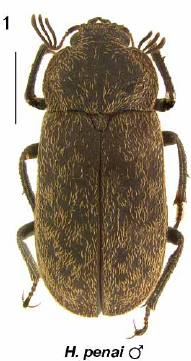| .. |
Scarabaeoidea of Southern South America Links
|
.
|
|
| |
| .. |
Scarab Guide Links
(goes to the University of Nebraska
web site) |
.
Classification |
Superfamily...
Family...........
Subfamily .....
Tribe............
|
Scarabaeoidea
Lucanidae
Aesalinae
Ceratognathini |
|
|
| |
|
| . |
.
Hilophyllus penai (Martínez, 1976)
Ceratognathus penai Martínez, 1976: 101. |
| |

|
Hilophyllus penai (Martínez) |
| |
|
Figure 19. Ventral view of male genitalia, H. penai. |
| |
|
Figure 22. Female genitalia of H. penai.
Terminology as in Holloway (1998): BC = bursa copulatrix, H = hemisternite, H9 = ninth
hemisternite, SD = spermathecal duct, SG? = spermathecal gland (not seen), SP = spermatheca, ST
= stylus. |
| |
|
Figure 25. Localities from which Hilophyllus specimens were examined: H. penai (asterisks), H.
argentinensis (squares), and H. martinezi (triangle). |
| |
|
...... |
Type specimens.
Holotype male (FMNH) labeled: a) “CARAMAVIDA / Nahuelbuta (W)”; b)
“(Arauco) 750 m / 25–31 Dic. 53 / Coll : L.E. Pena”; c) on pink paper, “HOLOTYPUS”;
d) on red paper, “Ceratognathus / penai (male symbol) / sp. nov.” / (typeset) “A.
MARTÍNEZ – DET. 19__”, (handwritten) “75”; e) “FMNH, 1986 / L.E. Pena Coll. / Acc.
“17-422”. One paratype male (CMNC) labeled: a, b as holotype; c) on yellow paper,
“PARATYPUS”; d) as holotype but on yellow paper; e) “H. & A. HOWDEN / COLLECTION / ex. A. Martinez coll.” One paratype male (CMNC) labeled exactly as other
paratype, except date of collection “1–10 Enero 54”. A female specimen subsequently
labeled as “ALLOTYPE” by Martínez (FMNH) was not listed in the original description
and is not part of the type series. |
| |
|
| |
Redescription.
Male (n = 5). Length: 8.4–8.9 mm. Width: 3.4–3.5 mm. Color/Surface: Reddishbrown
to dark brown, weakly shining. Dorsum covered with large punctures,
many with a single elongate, apically acute scale; scales unicolored, testaceous or golden
yellow. Head: Interocular width more than 2x width of eye in dorsal view. Mandibles
small, interlocking when closed, not longer than 1/2 length of head, apical tooth curved inward at middle in male; dorsal tooth broad, obtuse; ventral tooth of right
mandible present, variably developed, weak or reduced to angulation. Antennal club
segments elongate, as long as length of head. Pronotum: Sides narrowly explanate.
Anterior angle slightly produced, not constricted toward head. Lateral margin broadly
rounded, widest at middle. Elytra: Punctures lacking scales distributed in irregular
patches. Legs: Mesotibiae with external tooth. Male genitalia: Parameres elongate,
simple at apex (Fig. 19).
Female (n = 4). Differing from male in following characters: Length: 9.0–9.5 mm.
Width: 3.9–4.0 mm. Head: Width of eyes together in dorsal view subequal to 1/3
interocular width. Mandibles small, not strongly curved inward at middle; dorsal
tooth small, acute; ventral tooth of right mandible reduced to barely perceptible
angulation. Antennal club segments short, as long as 1/2 length of head.
Pronotum: Sides more narrowly explanate. Anterior angles constricted toward head.
Lateral margin not uniformly rounded, pinched inward anteriorly. Genitalia: See Fig. 22. |
| ...... |
|
| |
Diagnosis.
This species is distinguished by the presence of an external tooth on the mesotibia. In
addition, the elytral scale pattern is formed with irregular patches of unicolored, light
golden yellow scales that contrast with irregular patches that lack scales. The club
segments of the male antennae are much shorter than in males of the other species, being
only subequal in length to the head and mandibles combined. |
| |
|
|
Distribution.
CHILE: VIII Región. This species is apparently restricted to the forests on the west
slope of the Nahuelbuta Cordillera (see Remarks). |
| |
|
Locality Data. 9 specimens examined.
CHILE (9). VIII Región: Contulmo (1), west of P.N. Nahuelbuta (8). |
| |
|
Temporal Data. September (1), December (7), January (1). |
| |
|
Remarks.
Hilophyllus penai was previously known from only four specimens. Lack of
knowledge of the species' natural history probably added to its perceived rarity. In 2004,
we first collected a male and female of this species west of Parque Nacional Nahuelbuta
by splitting a fallen branch with an approximate diameter of 10 cm. Subsequently, JME
observed a male specimen sitting on a partially buried log. The log (possibly Nothofagus,
Nothofagaceae) contained termite galleries of the species Porotermes quadricollis
(Rambur) (Termopsidae), and dissection of the log resulted in the collection of two female
specimens of H. penai among the galleries. Because of this, we hypothesize that species
of Hilophyllus may be termitophilous. However, there are no apparent morphological
adaptations to termitophily in this species such as those found in other inquiline lucanids
(e.g. Penichrolucanus Deyrolle). It is interesting to note that at least one New Zealand
ceratognathine, Holloceratognathus passaliformis (Holloway), is myrmecophilous,
residing in the galleries of the ant Prolasius advena (Smith) (Holloway 1962, 1998). |
| |
| |
Excerpt from:
Paulsen, M. J. & J. Mondaca E. 2006. Revision of the South American Ceratognathini (Coleoptera:
Lucanidae: Aesalinae) with the description of a new genus and
a new species. Zootaxa 1191: 1–19. |
| |
|

